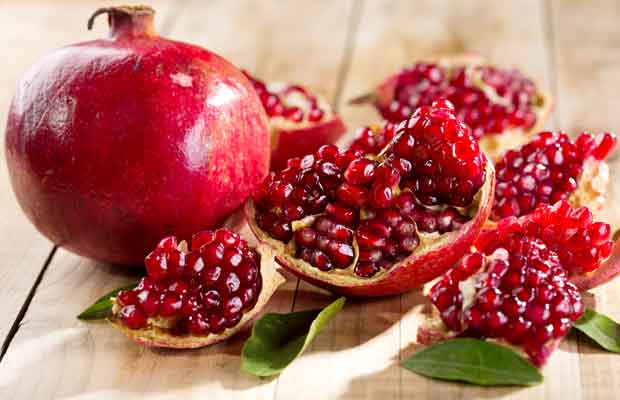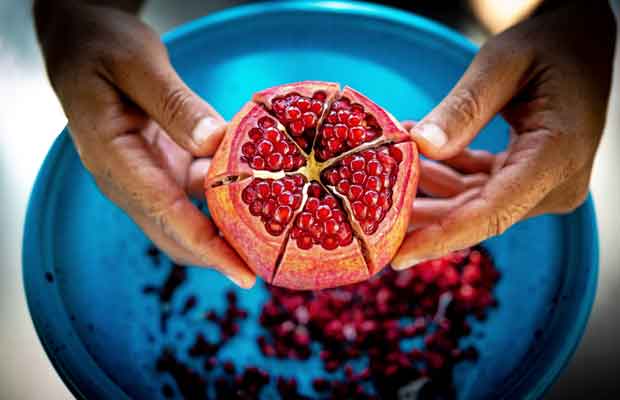Symbolism, salads and seeds: In praise of the pomegranate

Why the beautiful, easy-to-grow, health-giving pomegranate deserves its place in the garden.
Words: Kate Coughlan
When pomegranate seeds wink, glistening red and tempting from within a little carton on the supermarket shelf and the price tag puts them beyond reach, consider planting a pomegranate tree.
Pomegranates (Punica granatum) are easy to grow, starring at Christmas with glorious orange bursts in large tubular flowers and showing off glorious glowing orbs for the following three months.
By mid-to-late March, the fruit are ready to be picked. Cut them in half at the widest part, turn upside down over a bowl and bash their leathery bottoms with a stout spoon to release the juicy red seeds. The hearty might tackle the skins with the aid of a powerful blender and extract the maximum nutritional value by drinking the resulting liquid but chewing on seeds is enough for most.
HEALTH CLAIMS
A handful of seeds are claimed to help top-up Vitamins K and C, release antioxidants, reduce bad LDL and inflammation, fight infection and promote beneficial gut bacteria. What’s not to love about that list, even if science might not be available yet to secure every claim — and to which is often added fibre, protein, folate and potassium.

SYMBOLISM
Little wonder then that the pomegranate’s place in human nutrition and symbolism dates back to the most ancient of days. A large, dry pomegranate was found in the tomb of Djehuty, the butler of Queen Hatshepsut, a powerful Egyptian pharaoh of the 15th century BC. In Greek mythology, the seasons arose thanks to Persephone eating six seeds of a pomegranate before leaving her underworld prison. Before that, it’d been perpetual summer. Thanks, Persephone.
Other ancient peoples thought the calyx to be so perfect its sceptered form is still replicated in the crown shape today. Renaissance painter Sandro Botticelli, in his beautiful tondo Madonna of the Pomegranate, has the Virgin Mary holding a pomegranate in her left hand and the Baby Jesus resting his hand on it also. Maybe she too assigned it super-food powers given the strange turn her life had taken with an immaculate conception.
GROWING THEM
Jo Duff of Kahikatea Farms sells bagged, bare-rooted trees for $30 and is a bit of a fan.
“They are a plant-and-walk-away tree, the easiest of things to grow,” she says. “We’ve never sprayed ours, never pruned it, never fertilised it. It gets little to no attention and every year we get good fruit.”
The thing to watch for is wet feet, yet on Jo’s Hawke’s Bay clay the 10-year-old pomegranate has reached three metres and seems happy. The species originates in Asia and Iran and is best with a cold winter (no frosts below -10C) and a long hot summer as the fruit needs 90 days to ripen. Summer humidity can cause rot and a cool or wet summer can impact the degree of sweetness achieved by the end of the ripening period.
Jo says it is possible to prune a pomegranate for growing in a large patio container and it is a beautiful specimen to espalier. “Both the flowers and the fruit are gorgeous, in either flower or fruit it would make a great sight espaliered. We think of the pomegranate as our Christmas tree as that is usually when it is blooming best and they are exotic and glamorous.”
Pomegranates are deciduous and have spikes, so place it where no one has to brush against it and its early winter leaf drop won’t cause trouble.
“It wouldn’t be my number one tree to plant in the garden but it is multi-faceted with gorgeous foliage, exotic flowers and glorious fruit with health benefits,” says Jo.
The most commonly commercially available variety of pomegranates in New Zealand is Wonderful, which is available from most garden retailers.

HOW TO EAT THEM
Fresh pomegranates and arils are available widely. Eat the arils fresh, use in salads or as a garnish. Salads and arils are a match made in heaven.
Try your own version of these classics:
A green salad with avocado and arils for a contrasting taste, texture and colour sensation.
Pair fresh arils with fried halloumi, rocket and roasted walnuts
Toss arils over cooked lentils, fresh cherry tomatoes, finely sliced celery and kale.
Feta and finely chopped spinach marry beautifully with a generous handful arils too.
Chickpea, red onion, arils and cucumber – all diced to the same size. Sub-out the chickpeas with kumara for a sweet-tooth salad.
Or try these recipes from Eat Yourself Healthy, which has a whole section dedicated to the ruby-red fruit:
POMEGRANATE MOLASSES
This staple of Persian cuisine comes from the juice of the fruit, reduced by boiling with sugar and citrus juice. Making pomegranate molasses isn’t a goer unless you have an abundance of fruit, as 1 cup of molasses requires 8 large pomegranates. The molasses is widely available and, like all sweet and sour ingredients, it is a betwitching substance.
A simple combination of extra virgin olive oil and a quarter the same amount of pomegranate molasses makes a delicious dip for fresh focaccia bread.
Muhamara, a roasted red pepper dip, has an alarmingly long list of ingredients but the one essential (in addition to the red peppers) is the pomegranate molasses. Oh, I guess the toasted walnuts are also crucial.
Fesenjoon, the popular celebration dish in Iran, pairs pomegranates with their best friend, the walnut over their third bestie – chicken. Here is Maman’s Fesenjoon (from Eat Yourself Healthy) for that special and exotic dish.
DRINK IDEAS
Drop a small handful of arils into a glass of sparkling wine or champagne. Next level bubbles and so pretty.
Whizz a cup of pomegranate arils in a blender for a high health drink (pasteurised juice does not contain as much of nutrient as fresh).
For a non-alcoholic spritzer, use tall ice-filled glasses and fill with half fresh pomegranate aril juice and soda, sprinkled with finely chopped mint, a few whole arils and swirled into the mix.
Cheers!


